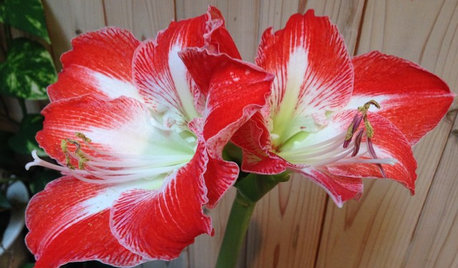Is there an Amaryllis Doctor in the House?
Judy Brown
14 years ago
Related Stories

HOUSEPLANTSHow to Force Amaryllis Bulbs Indoors
Enjoy vibrant red blossoms even as gardens turn snowy white, by teaching this hardy repeat performer to ignore the calendar
Full Story
WINTER GARDENINGHow to Get an Amaryllis to Rebloom
Enjoy glorious flowers year after year just when you need them most, with this step-by-step strategy
Full Story
HOUZZ TOURSMy Houzz: Industrial Style in a Converted Doctor’s Office
An elegant art collection and an open layout mark this couple’s Uptown New Orleans apartment
Full Story
DECORATING GUIDESSo Your Style Is: The Doctor Is In
Are medical accessories your go-to Rx for style? Find out how to use them in a healthy balance
Full Story
DECORATING GUIDESRoom Doctor: 10 Things to Try When Your Room Needs a Little Something
Get a fresh perspective with these tips for improving your room’s design and decor
Full Story
PRODUCT PICKSGuest Picks: Daily Doses of Apothecary Chic
Just what the doctor ordered for cool decor: old-time furnishings and accessories updated for today
Full Story
HEALTHY HOMEHow to Choose a Home Water Filtering System
Learn which water purification method is best for your house, from pitchers to whole-house setups
Full Story
LIFEThe Polite House: What’s an Appropriate Gift to Welcome a New Neighbor?
Etiquette expert Lizzie Post suggests the right time and best presents to introduce a new neighbor to your area
Full Story
LIFEThe Polite House: How to Deal With Noisy Neighbors
Before you fly off the handle, stop and think about the situation, and follow these steps to live in harmony
Full Story
SELLING YOUR HOUSEHow to Decorate for the Holidays When Your Home Is for Sale
You can make your home appealing to potential buyers and still celebrate the season. Here are 7 tips to keep in mind
Full Story


tamelask
Judy BrownOriginal Author
Related Discussions
Tomato Trouble: Any Doctors in the House?
Q
Is there an (Aeonium) Doctor in the house?
Q
Anyone Running a "Plant Doctor" Service for Home Plants?
Q
Is there a Doctor in the house
Q
trianglejohn
tamelask
Judy BrownOriginal Author
trianglejohn
Judy BrownOriginal Author
tiarella
Judy BrownOriginal Author
joerd
Judy BrownOriginal Author
joerd
joerd
safariofthemind
joerd
trianglejohn
tamelask
safariofthemind
tamelask
trianglejohn
tamelask
joerd